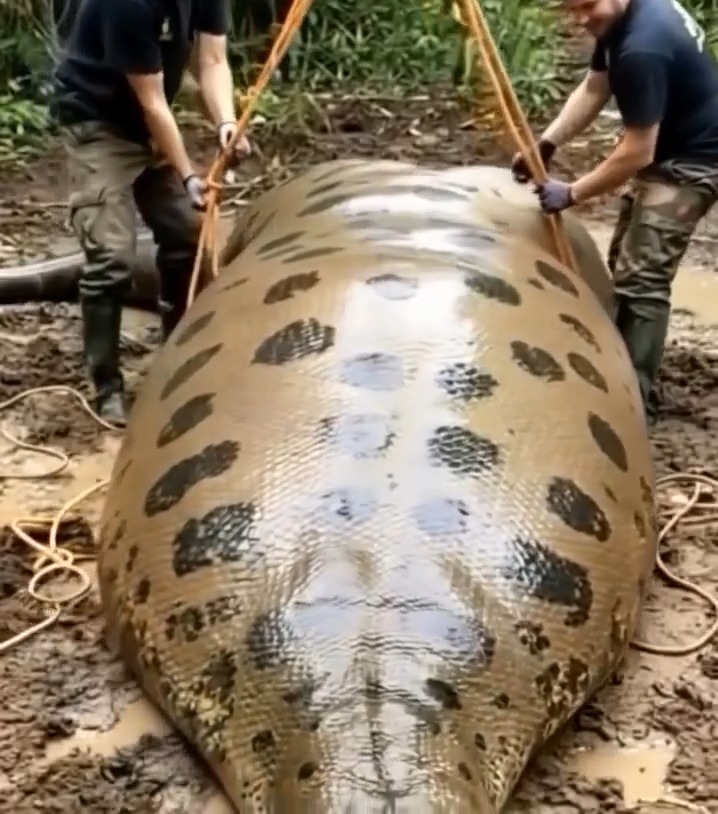It began as an ordinary day deep within a tropical rainforest in Southeast Asia—a group of seasoned hikers set out on what they thought would be a challenging but uneventful trek. The air was thick with humidity, the sound of cicadas echoed through the trees, and sunlight filtered through the dense canopy like liquid gold. But as they ventured deeper into the wild, nature presented them with something that would blur the line between science and legend—a sight so extraordinary that it would later make headlines around the world.

At first, the hikers noticed an odd stillness in the forest. Birds that had been chattering moments earlier had gone silent, and even the usual rustle of small creatures seemed to vanish. Then, in a clearing surrounded by towering bamboo, they saw it—a massive snake lying motionless across the forest floor. It was unlike anything they had ever encountered. Its enormous body stretched across nearly twenty feet of ground, its scales glistening like wet armor in the sunlight. Even from a distance, they could tell this creature dwarfed any known species, larger than the biggest pythons or anacondas ever recorded.
At first glance, it looked as though the snake had recently eaten. Its belly was distended, unnaturally round, as if it had swallowed something far too large. But what drew the hikers closer was a strange, rhythmic sound coming from inside the creature—a faint thumping that seemed almost alive. The sound made their hearts race. What could possibly be moving inside a snake that large? Was it the remnants of some animal fighting its final moments? Or something far more mysterious?
Despite their fear, curiosity pulled them closer. With careful steps, they examined the creature from head to tail. Its mouth was slightly open, revealing long, curved fangs that gleamed in the sunlight. The air around them was heavy with tension and the unmistakable scent of decay. One of the hikers, a wildlife researcher, whispered that this could be a new, undocumented species. Others thought it might be the same serpent rumored for decades in local folklore—a “forest guardian,” said to be as ancient as the jungle itself.
The group decided to investigate further. Using the tools they carried, they cautiously began to examine the snake’s midsection. Their hands trembled as they realized the bulge wasn’t shaped like an animal. It was smoother, longer—and disturbingly human-like. Panic rippled through the group. Nobody wanted to believe what their eyes were telling them. But when they finally made a small incision, their worst fears were confirmed.
Inside the enormous creature was a human form.
For several seconds, no one spoke. The forest, once alive with sound, seemed to hold its breath. The group stood frozen, processing what they had just uncovered. The figure appeared to be that of a woman, preserved within the snake’s body in a way that defied understanding. Some of the hikers stepped back in horror, while others, unable to turn away, tried to comprehend the impossible sight before them.
News of the discovery spread like wildfire. Photos and witness accounts were quickly shared with local authorities and wildlife experts. Scientists rushed to the remote area to verify the claim, and soon, the story captivated the global imagination. How could such a massive creature exist in modern times without detection? And who was the woman? Speculations swirled—some believed it to be a tragic accident, others thought she might have been lost in the jungle for days before crossing paths with the snake. There were even those who argued it was a myth come to life, proof that legends sometimes grow from seeds of truth.
As researchers studied the remains, they noted that the snake’s anatomy didn’t perfectly match any known species. Its bone structure, muscle density, and even the scale patterns suggested something entirely new—possibly a subspecies that had evolved in isolation. The discovery challenged existing scientific knowledge and sparked debates across the globe. Wildlife biologists called it an “evolutionary anomaly,” while skeptics insisted it was a hoax or an elaborate misidentification.
Local villagers, however, weren’t surprised. To them, the jungle had always been full of mysteries. They spoke of ancient spirits and guardian creatures that protected sacred lands from intruders. According to one elder, a serpent of extraordinary size was said to appear once in a century, a symbol of nature’s balance and vengeance. Whether the hikers had stumbled upon that very legend or not, their find reignited old tales passed down through generations.
In the aftermath, the site became the focus of intense study and debate. Teams from universities and conservation groups arrived to document the snake’s remains. DNA samples were taken, though early results were inconclusive. Some samples hinted at genetic links to known pythons, while others suggested unique mutations never seen before. What fascinated scientists most was how such a creature could remain hidden in a region that, despite its remoteness, had been extensively explored.
The identity of the woman also became a point of speculation. Authorities launched an investigation to determine who she was and how she had ended up in the snake’s path. Reports suggested she might have been a local villager who disappeared weeks earlier, though no definitive confirmation was ever made public. Her story, tragic and mysterious, added a haunting layer to an already unbelievable discovery.
Over time, the tale took on a life of its own. Documentaries, news segments, and online forums dissected every detail. Was the creature real? Could such a massive snake have survived into the modern era? And if so, what else might be lurking in the world’s unexplored corners? The incident reignited humanity’s fascination with the unknown—the idea that even in an age of satellites and science, nature still holds secrets beyond comprehension.
In the end, the discovery deep in that Southeast Asian jungle served as more than just a biological mystery—it became a symbol. A reminder that nature’s power remains untamed and that humility is essential when facing the wild. Whether one believes in the scientific explanation or the whispered legends, one truth stands firm: the world is far larger, stranger, and more awe-inspiring than we imagine.
Perhaps the greatest lesson from that day wasn’t about the creature itself, but about the limits of our understanding. Sometimes, the line between fact and folklore isn’t as clear as we think. The hikers set out to explore the forest, but instead, they uncovered a story that would echo across continents—a story that challenges us to look at nature not as something fully known, but as a living mystery waiting to reveal its next secret.





